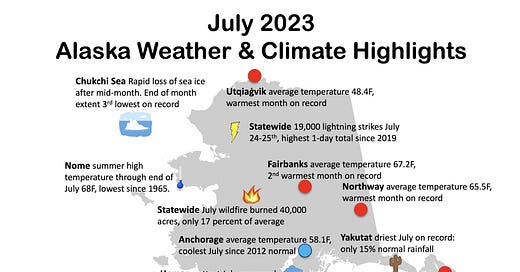There is a lot going on with Alaska and Arctic climate this summer, so this post will just hit on some July highlights for Alaska. More details and bigger pictures in the coming days.
Highlights
Temperature and precipitation are detailed below, but there was plenty of action in other sectors in July. Seasonal wildfire in Alaska was at unprecedented low levels until an unusually late season thunderstorm outbreak on July 24 sparked dozens of wildfires, some near communities.About 19,000 lightning strikes in Alaska between 6am July 24 and 6am July 25th was the highest single day strike count in Alaska since July 2019. Resulting fires in the Anderson area, south of Nenana, and near Salcha resulted in several evacuation notices during the last days of the month. Sea ice in the Chukchi Sea was slow to melt early in the month but then the melt increased dramatically the second half of the month, with ice extent on July 31st the third lowest in past 45 years (only 2017 and 2019 lower). Beaufort Sea sea ice extent was below all month.
Temperature Highlights:
July was warmer than normal over much Alaska and far above normal in some areas. The only region cooler than normal was in the Anchorage area south to Kodiak Island and west into parts of Southwest mainland. Anchorage, Kenai and Kodiak all had the coolest Julys since 2012. However, warmth was the big story.
July 2023 average temperature was the warmest for any month on record at:
Utqiaġvik 48.4F (9.1C), previous warmest month was July 2019: 48.3F (9.1C)
Eagle (cooperative) 65.5F (18.6C) previous warmest month was June 2004: 65.2F (18.4C)
Northway 65.5F (18.6C) previous warmest month was July 2019: 62.4F(16.9C)
Tok 64.7F (18.2C) previous warmest month was July 1988: 63.2F (17.3C)
Ft. Greely/Delta Junction 65.3F (18.5C) previous warmest month was July 2009: 64.7F (18.2C).
Second warmest month at:
Fairbanks 67.1F (19.5C), July 1975 was warmer
Deadhorse/Prudhoe Bay 53.8 (12.1C), July 1989 was warmer
Third warmest month at:
Juneau Airport 60.4F (15.8C), July 2018 & 2019 were warmeJ
Precipitation Highlights
There was a dramatic contrast in July rainfall that was partly but not entirely correlated with temperature departures. Much of Southcentral had well above normal rainfall, but so much of western Alaska where monthly temperatures average near or slightly above normal. A large part of the central Interior and all of Southeast had well below normal rainfall. In parts of the Tanana valley southeast of Fairbanks this followed an unusually dry June, such that Ft. Greely/Delta Junction total June and July rainfall was the lowest of record. In contrast, the NOAA Climate Reference Network station at Aleknagik had more than three times the normal rainfall for June and July combined. On the North Slope, at or near record warm temperatures also saw generally above normal rainfall.
Homer Airport: 4.25 inches (108.0mm) rainfall was easily the most in any July. Previous July record was 3.79 inches (96.3mm) in 1948.
Anchorage Airport 4.08 inches (103.6mm) rainfall was actually slightly less than July 2022 but still high enough to rank as sixth highest (since 1952).
Yakutat Airport reported only 1.14 inches (29.0mm) of rain in July is the lowest on record. Previous record was 1.20 inches (30.5mm) in July 1920.
Denali National Park Headquarters: 0.66 inches (16.7mm) of rain in July is the lowest on record. Previous record was 0.76 inches (19.3mm) in July 1955 and again in 1994.
Gulkana Airport 0.54 inches (13.7mm) was the third lowest, only 1994 and 1976 lower.
Juneau Airport 1.79 inches inches (29.0mm) of rain was the lowest in July since 1982 and the fourth lowest overall.






